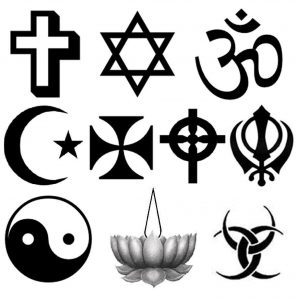Models for Engaging Religious Diversity
Source: Internet Encyclopedia of Philosophy
One of the roles of the Center for Faith and Vocation is to invite students to engage the diverse religious communities on campus and in the community. The CFV Interfaith Council and CFV Scholars embrace this opportunity for interreligious engagement as central to their mission, but the CFV also offers workshops, lectures, film discussions, and other opportunities for engaging with religious diversity. This semester I am teaching an upper-level Religion course called “Religious Pluralism” and our focus is on the various ways Christian theologians have thought about religious diversity and the relationship between religious traditions.
In my role as CFV Scholar in Residence I work with the CFV Scholars to help them reflect more intentionally on their encounters with religious diversity; as a Christian theologian one of my tasks is to make sense of religious diversity from a Christian theological perspective. Religious diversity itself is simply a fact: there are multiple religious traditions in the world and even on Butler’s campus. But Christians and other religious people have disagreed about how to make sense of that diversity in light of their own religious commitments. In my course we start the semester with an introduction to these questions, Paul Knitter’s Introducing Theologies of Religion. In this helpful book, Knitter (a Roman Catholic theologian) proposes four “models” Christian theologians have used to make sense of the relationship between Christianity and other religious traditions.
The first model is Replacement, or “exclusivism.” In this model, Christianity alone is true and all other religions are understood to be false and misguided ways to God. Only Christians can be saved, so in this model the goal of dialogue is conversion. This model is typically espoused by conservative evangelical and fundamentalist Christians.
The second model is Fulfillment, or “inclusivism.” In this model, Christianity alone possesses the fullness of truth, but other religious traditions can also include glimmers of God’s truth. Non-Christians who devote themselves fully to their tradition and who seem to live holy and grace-filled lives are considered to be “anonymous Christians.” Jesus Christ is the sole savior of the world, so if anyone is saved, they are saved by Christ, but in this model Christ can be active outside of Christianity. This model is typically espoused by Roman Catholics and mainline Protestants.
Replacement and Fulfillment are the dominant models in most Christian churches, at least in terms of their official teachings. However, two additional models are becoming more popular, especially in Roman Catholic and mainline Protestant circles.
The third model is Mutuality. In this model, all religious traditions are understood to be the product of particular cultures, each responding to the Ultimate Reality with the help of the language, concepts, customs, and worldview of their respective cultures. All religious traditions are assumed to have “rough parity” and all are assumed to be headed toward the same goal of union with Ultimate Reality. Each tradition uses different symbols for that reality and develops different doctrines, rites, texts, etc., to make sense of it, but all religious traditions share the same essence and the same goal. This means, then, that no religious tradition can claim to uniquely possess the final and ultimate truth. A common metaphor for this model is that all religions are paths up the same mountain. The goal of dialogue in this model is to develop a deeper understanding of what all religions have in common.
The fourth model is Acceptance. This model developed in response to the Mutuality model, which some theologians criticized for ignoring or downplaying the genuine differences between religious traditions. Acceptance theologians emphasize the differences more than the similarities: the religions are really different, and that’s a good thing! Some Acceptance theologians even suggest that there are multiple “ultimates,” multiple “absolutes,” and multiple “salvations.” Furthermore, each religious tradition can only be fully understood on its own terms, from the inside, because each religious tradition has its own thought-world and its own symbol-system that can’t be “translated” without losing something essential. The goal of dialogue in this model is to develop a richer understanding of these differences in order to make me a better Christian and you a better Muslim, Jew, Buddhist, Hindu, etc.
Each of these models has its strengths and weaknesses (as all models do), and each model tries to balance what Knitter calls the Christian “teeter-totter” of the uniqueness and particularity of Jesus Christ on the one side and the universal love of God on the other. Each model approaches the “teeter-totter” differently, and other religious traditions will try to balance their own “teeter-totters” in similarly diverse ways.
These four models invite us to think deeply and seriously about the reality of religious diversity while also trying to make sense of the truth claims of our own religious tradition in light of that diversity. For some, one of the models will strike us as doing a particularly good job of balancing that “teeter-totter,” while for others none of the models will be successful. It’s very possible that additional models are needed to help us live fruitfully and faithfully in a religiously diverse world.
Brent Hege
CFV Scholar in Residence and Lecturer in Religion

One thought on “Models for Engaging Religious Diversity”
I gave organic cbd sleep gummies a prove with a view the maiden previously, and I’m amazed! They tasted smashing and provided a sanity of calmness and relaxation. My importance melted away, and I slept better too. These gummies are a game-changer for me, and I enthusiastically recommend them to anyone seeking unconstrained emphasis recess and well-advised sleep.